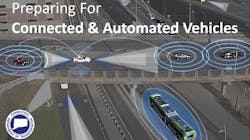CTDOT releases first strategic plan for connected, automated vehicles
The first statewide Strategic Plan for Connected and Automated Vehicles (CAV) was released by the Connecticut Department of Transportation (CTDOT) to support emerging transportation technology and mobility trends.
Specifically, the plan outlines strategies for advancing multimodal CAV-related services and infrastructure to address both current and evolving transportation needs.
Connected vehicles (CV) are vehicles that wirelessly communicate with other vehicles, roadside infrastructures, pedestrians and the cloud. Automated vehicles (AV) are those capable of performing all or part of the real-time vehicle operations in on-road traffic. The strategic plan explores ways connected and automated vehicles, or CAV technologies, could become a powerful tool in helping meet key CTDOT goals to improve safety; enhance mobility, accessibility and reliability; reduce congestion; support infrastructure state of good repair; provide efficiencies; reduce vehicle emissions and support economic growth.
“Over the next few decades, advancing CAV technologies has the potential to drastically change mobility and our transportation systems in Connecticut and across the country,” said CTDOT Commissioner Joseph Giulietti. “As innovation around these technologies continues to develop at a fast pace, we’re focused on ways Connecticut can benefit, especially with the potential for CAV to dramatically improve transportation safety.”
Nearly 95 percent of roadway crashes in the United States are caused by some form of human error, which kills close to 40,000 Americans each year. In a typical year in Connecticut, CTDOT says more than 100,000 crashes, more than 30,000 injuries and more than 250 deaths are the result of human error. Should CAV technological capabilities continue to mature, and market penetration rates increase, there is potential for significant improvements in transportation safety. This may allow Connecticut as well as other states around the country to better achieve their transportation safety goals and ultimately get much closer to zero deaths on the roadway.
As part of the strategic plan, CTDOT establishes a vision for the future of CAV that is safe, secure and seamlessly operated across all jurisdictions. Building off this vision, CTDOT has developed near-term and long-term strategies that maximize the potential benefits of still evolving CAV technologies.
In the near-term (2021-2025), CTDOT will focus actions on the multiple facets of CAV technologies where there are significant advancements by both industry and public sector. This includes activities such as deploying pilot projects, early policy coordination and development, assessments of workforce and infrastructure readiness and other activities.
In the long-term (beyond 2025), CTDOT will maintain a timely feedback loop to adapt and engage with the pace of advancements in CAV technologies, policies and readiness. CTDOT will also look for opportunities to implement infrastructure programs and services at larger scale to support advances in CAV technologies, subject to CTDOT’s own capabilities, available funding, national standards and policies, technology readiness and market penetration.
The CTDOT CAV Strategic Plan represents a snapshot in time and will be revisited and updated in response to changing technologies; evolving federal, state and local laws and regulations; and shifts in Connecticut’s transportation needs and priorities.



